How to Maintain Your Paint Protection Film for Your Car
Paint protection film is a great way to safeguard your car's paint from scratches, debris, and other potential damage. However, proper maintenance is key to ensuring its longevity and effectiveness.
To get the most out of your paint protection film, it is important to follow a maintenance routine that includes regular cleaning and care. By taking the necessary steps to preserve your paint protection film, you can keep your car looking its best for years to come.
General Care & Maintenance of Your Paint Protection Film

Your vehicle's paint protection film is a valuable shield that keeps your car looking brand new. To maintain its effectiveness and preserve the appearance of your vehicle, regular cleaning and maintenance are essential. Starting with the basic cleaning tools, it's important to use materials that are gentle on the film. A soft microfiber wash mitt or cloth is ideal for washing and drying the film, ensuring that no harsh fibers or abrasive materials come into contact with it. We also recommend using a pH-neutral car wash soap as a cleaning solution to prevent any damage to the film.
Using a pH-neutral soap is crucial because acidic or alkaline-based cleaners can cause premature breakdown or discoloration of the film, compromising the protective properties it offers. When it comes to the actual cleaning process, it's advisable to wait for an appropriate time after applying the film before you start cleaning. This gives the film sufficient time to set and adhere properly. Typically, we recommend waiting for at least 48 hours after application before attempting to clean the film, with a full week being optimal for the first cleaning.
Daily exposure to environmental factors such as UV radiation, dirt, and road debris can take a toll on your PPF. Regular cleaning helps remove these contaminants, preventing them from causing damage that may compromise the protective properties of the film. Regular cleaning not only keeps your vehicle looking pristine but also prevents potential damage caused by these contaminants.
With proper general care and maintenance, your paint protection film will continue to effectively safeguard your vehicle's paint while preserving its aesthetic appeal and resale value.
Procedures for Cleaning Your Paint Protection Film
Gentle Wash
The key to a successful clean is to use a gentle approach. You want to remove dirt and debris without harming the film itself. This means employing a microfiber wash mitt or cloth along with plain water or a recommended cleaning solution.
The microfiber material is extra gentle on the film, ensuring it won't cause any scratches or damage. Just like using a soft brush to delicately clean a painting, this ensures the perfect amount of care without being harsh. Remember to only use cleaning solutions specifically designed for PPF maintenance, avoiding harsh chemicals that could cause more harm than good.
Thorough Rinse
After completing the gentle wash, giving your PPF a thorough rinse is crucial. This will guarantee the complete removal of all cleaning residue, leaving your film spotless and gleaming. Once the rinse is complete, you have two options for drying: air dry or use a clean microfiber cloth to dry the surface gently.
Using a microfiber cloth to dry your PPF guarantees the removal of any water spots and prevents unnecessary rubbing that could potentially damage the film. Similar to carefully patting down an intricate piece of jewelry after cleaning it to ensure there are no watermarks or damage.
Caution with Cleaning Solutions
Sticking to the recommended mild soap and water solutions for PPF maintenance is key here. Mild soap is safe and effective, preserving the protective properties of the film without causing harm.
By incorporating these specific procedures into your regular maintenance routine, you actively contribute to the longevity and effectiveness of your PPF.
Safeguarding Your PPF from Damage

Avoiding Damage Sources
Bug splatter, bird droppings, and other acidic substances may seem innocuous, but they act as tiny enemies that can erode the protective film over time. However, regular cleaning is your best defense against these harmful elements.
By keeping your PPF clean, you ensure that acidic substances don't have a chance to settle in and cause damage. Regular maintenance with a mild soap and water solution can help keep these malevolent substances at bay.
Preventing Abrasion
Just as you wouldn't scratch a knight's armor, treating your PPF with care helps maintain its integrity and durability. It's essential to avoid actions that put pressure or abrasion on the film. This means steering clear of scrubbing sponges, bristled brushes, or power buffers when cleaning your car.
Furthermore, automatic car washes and pressure washers can also be harmful. Strong detergents and high-pressure water streams can wear down the protective layer of the film. Instead, hand-washing with a pH-neutral car wash soap and a microfiber wash mitt is a safer bet for preserving the life of your PPF.
Recognizing & Solving Common PPF Issues
Yellowing or Discoloration
Yellowing or discoloration over time is one of the most frustrating problems that PPF owners encounter, caused by prolonged exposure to sunlight, certain cleaning products, or environmental pollutants. If you notice any yellowing or discoloration, consult a professional for advice on addressing this issue.
They may recommend specific treatment options or replacement of the affected areas to restore the film's clarity and protective properties.
Peeling or Lifting
Improper installation, impact damage, or aging of the film can also cause peeling or lifting of the PPF. If you notice any peeling or lifting edges, immediately seek professional assistance to prevent further deterioration and ensure the film's continued effectiveness in protecting your vehicle's paint.
Water Spotting
Water spotting can be an issue for PPF owners, particularly in areas with hard water. Regular cleaning routines are vital in preventing water spots from forming on the film. Using recommended cleaning solutions and thoroughly rinsing and drying the film after each wash can help mitigate the risk of water spotting and preserve the PPF's appearance.
Adhesive Residue
Promptly address adhesive residue using suitable removal agents recommended by professionals to avoid damaging the underlying paint surface and maintain the integrity of the PPF.
Understanding these common issues early and taking appropriate action greatly impacts the longevity and effectiveness of your paint protection film. By staying vigilant and addressing these concerns proactively, you can ensure that your PPF continues to provide reliable protection and maintains a pristine appearance for years to come.
With a better understanding of these common PPF issues and how to address them, you'll be well-equipped to effectively maintain the condition and performance of your paint protection film.
Keep Your Car Looking New With Our Paint Protection Film Services

At Naples Auto Armour, our paint protection film services in Naples, FL, are designed to keep your car looking new and pristine. With our high-quality film, your car will be protected from any damage that could occur on the road.
Our paint protection film will give you peace of mind and ensure that your car stays in perfect condition for years to come.
Contact us today at
(239) 378-2336 to schedule an appointment and give your car the protection it deserves. Don't wait until it's too late!
Naples Auto Armor Blog











